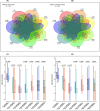Sensitization to molecular dog allergens in an adult population: Results from the West Sweden Asthma Study
- PMID: 35984703
- PMCID: PMC10087160
- DOI: 10.1111/cea.14216
Sensitization to molecular dog allergens in an adult population: Results from the West Sweden Asthma Study
Abstract
Background: As the prevalence of dog allergy rises, component resolved diagnosis might improve the diagnosis, understanding of the clinical outcomes and the effectiveness of immunotherapy. Considering the paucity of data in adults, the current study characterized the patterns of sensitization to dog molecular allergens in an adult population.
Methods: Data were derived from the West Sweden Asthma Study, a population-based and representative sample of adults from western Sweden. Of the 2006 subjects clinically examined, 313 participants sensitized to whole dog allergen extract were measured for specific immunoglobulin E (sIgE) levels to Can f 1, Can f 2, Can f 3, Can f 4, Can f 5 and Can f 6 using ImmunoCAP™. Polysensitization was defined as sensitization to ≥3 components. Overlapping sensitization was defined as having concomitant sensitization to at least two dog molecular allergen families (lipocalin, albumin or prostatic kallikrein).
Results: Of 313, 218 (70%) subjects tested positive to at least one dog allergen component. Sensitization to Can f 1 (43%) was the most common, followed by Can f 5 (33%) among molecular allergens, while sensitization to lipocalins (56%) was the most common among component families. Polysensitization was found in 22% of all participants and was more common in participants with than in those without asthma. Subjects with asthma were less likely to be monosensitized to Can f 5 than those without asthma. Subjects with asthma had higher IgE levels of Can f 3, Can f 4 and Can f 6 than those without asthma. Overlapping sensitizations also differed between those with asthma and allergic rhinitis and those without.
Conclusion: Increased knowledge about the sensitization patterns of dog allergen components can aid in defining their role in asthma and rhinitis. In complex clinical cases of dog allergy, a detailed analysis of dog allergen components can provide additional information on the nature of sensitization.
Keywords: Can f 1; Can f 5; component resolved diagnostics; dog allergy; dog dander sensitization; dog molecular allergen components; furry animal allergy.
© 2022 The Authors. Clinical & Experimental Allergy published by John Wiley & Sons Ltd.
Conflict of interest statement
M.P. Borres is employed by Thermo Fisher Scientific (Uppsala, Sweden). B. Lundbäck and J. Lötvall have received material from Thermo Fisher to perform the IgE analyses for this work. The rest of the authors declare that they have no relevant conflicts of interest related to this work.
Figures





Similar articles
-
Furry Animal Allergen Component Sensitization and Clinical Outcomes in Adult Asthma and Rhinitis.J Allergy Clin Immunol Pract. 2019 Apr;7(4):1230-1238.e4. doi: 10.1016/j.jaip.2018.12.018. Epub 2018 Dec 27. J Allergy Clin Immunol Pract. 2019. PMID: 30594587
-
Characterization of sensitization to furry animal allergen components in an adult population.Clin Exp Allergy. 2019 Apr;49(4):495-505. doi: 10.1111/cea.13355. Epub 2019 Feb 27. Clin Exp Allergy. 2019. PMID: 30697845
-
A population-based study of animal component sensitization, asthma, and rhinitis in schoolchildren.Pediatr Allergy Immunol. 2015 Sep;26(6):557-63. doi: 10.1111/pai.12422. Epub 2015 Jul 30. Pediatr Allergy Immunol. 2015. PMID: 26059105
-
Component-Resolved Diagnosis in Allergic Rhinitis and Asthma.J Appl Lab Med. 2019 Mar;3(5):883-898. doi: 10.1373/jalm.2018.026526. Epub 2018 Nov 12. J Appl Lab Med. 2019. PMID: 31639763 Review.
-
Component-resolved diagnostics in pet allergy: Current perspectives and future directions.J Allergy Clin Immunol. 2021 Apr;147(4):1164-1173. doi: 10.1016/j.jaci.2020.12.640. Epub 2021 Jan 11. J Allergy Clin Immunol. 2021. PMID: 33444632 Review.
Cited by
-
Sensitization patterns to cat molecular allergens in subjects with allergic sensitization to cat dander.Clin Transl Allergy. 2023 Aug;13(8):e12294. doi: 10.1002/clt2.12294. Clin Transl Allergy. 2023. PMID: 37632243 Free PMC article.
-
Molecular Signatures of Aeroallergen Sensitization in Pediatric Populations: A Comparative Study Across Spanish Cities.Int J Mol Sci. 2025 Mar 25;26(7):2963. doi: 10.3390/ijms26072963. Int J Mol Sci. 2025. PMID: 40243575 Free PMC article.
-
A Single Multiplex CytoBas Assay Incorporating Eight Major Components for Accurate Detection of Allergen Sensitization in Asthma and Allergic Rhinitis.Allergy. 2025 Apr;80(4):1047-1059. doi: 10.1111/all.16513. Epub 2025 Mar 7. Allergy. 2025. PMID: 40052465 Free PMC article.
-
Inhalant Mediated Allergy: Immunobiology, Clinical Manifestations and Diagnosis.Clin Rev Allergy Immunol. 2025 Apr 15;68(1):43. doi: 10.1007/s12016-025-09053-2. Clin Rev Allergy Immunol. 2025. PMID: 40234356 Free PMC article. Review.
-
Furry Animal Allergy: Lipocalins, Serum Albumins, and Secretoglobins-Cross-Reactivity, Diagnosis, and Management Strategies.Clin Rev Allergy Immunol. 2025 Jul 30;68(1):75. doi: 10.1007/s12016-025-09086-7. Clin Rev Allergy Immunol. 2025. PMID: 40739451 Free PMC article. Review.
References
-
- Schoos AM, Nwaru BI, Borres MP. Component‐resolved diagnostics in pet allergy: current perspectives and future directions. J Allergy Clin Immunol. 2021;147(4):1164‐1173. - PubMed
-
- Custovic A, Simpson A, Woodcock A. Importance of indoor allergens in the induction of allergy and elicitation of allergic disease. Allergy. 1998;53(48 Suppl):115‐120. - PubMed
-
- Curin M, Reininger R, Swoboda I, Focke M, Valenta R, Spitzauer S. Skin prick test extracts for dog allergy diagnosis show considerable variations regarding the content of major and minor dog allergens. Int Arch Allergy Immunol. 2011;154(3):258‐263. - PubMed
Publication types
MeSH terms
Substances
LinkOut - more resources
Full Text Sources
Medical
Research Materials

